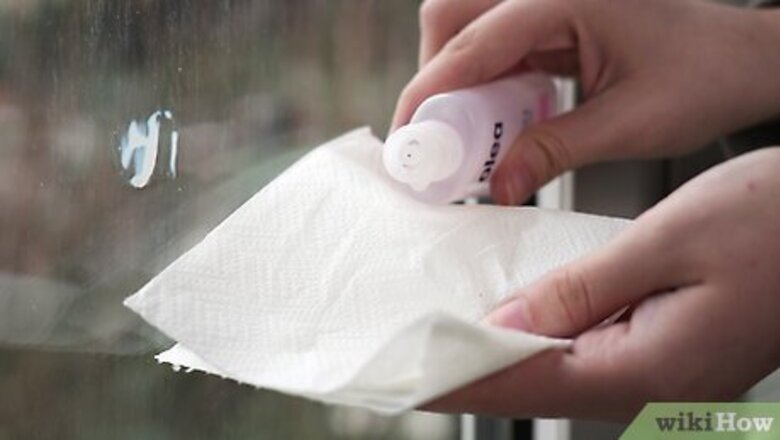
views
Cleaning Dried Glue
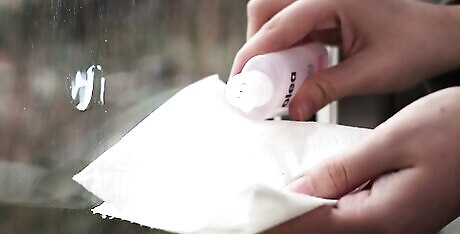
Rub the glue with rubbing alcohol or nail polish remover. Pour a cap's worth of rubbing alcohol or nail polish remover onto a paper towel. Rub in a circular motion to soften glue or paint. You don't need much – remember that a small, concentrated dose of solvent will be much more effective than splashing the window at large. Go over the spot with a regular glass-and-window-cleaning spray. Rub the spray into the surface with a fresh rag. This will help you lift leftover smudges – and it will help cover up the smell of the alcohol or nail polish remover.

Use white vinegar to remove residue left by masking tape. This method works well for window glass on which the tape has been left for too long or has dried out quickly in the hot sun. Wipe the residue a couple of times with a soft cloth that is damp with vinegar. Let the adhesive sit for a minute, then rub off the residue with a fresh piece of your already-dampened cloth. Keep rubbing and applying more vinegar until you have removed all of the dried-on adhesive. Dry and polish with a clean cloth.
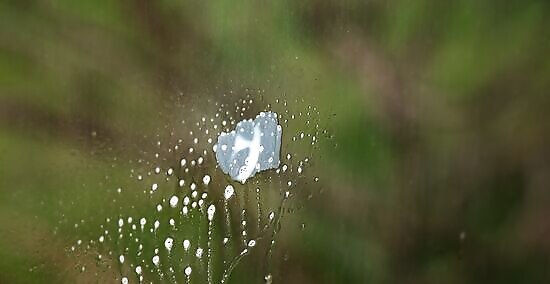
Use commercial degreasing agents. Head to your local auto store – there are plenty of products that can give you a leg up when tackling stubborn adhesives. Look for brands like Fast Orange, Goof-Off, and Goo Gone. These products are designed for cleaning motor oil and grease from hands, but they work just as well for sticker, tape, and glue residue because they contain powerful degreasing agents. In the case of citrus cleaners like Fast Orange, the degreasing agent is usually d-Limonene. Others rely on heptanes, a powerful solvent. For the sake of safety, make sure to use both types of products in small doses, in a well-ventilated area.
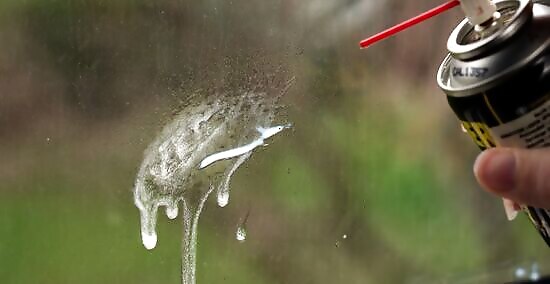
Use WD40 or paint thinner. Spray either product directly onto the glue and scrub the surface with a clean rag.
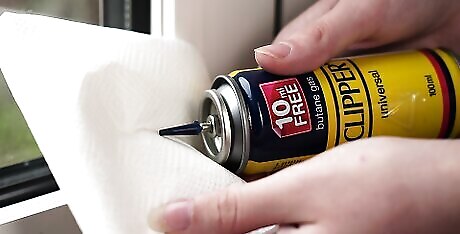
Use lighter fluid. Squirt the fluid onto a rag or paper towel, and be careful not to spill. Scrub the glue spot with the damp towel until you remove all of the glue. Alternately, soak the glue in lighter fluid to loosen the adhesive. Squirt or dab the lighter fluid directly onto the glue patch, in a concentrated area. Let it set for a minute, then wipe it off with a clean, damp towel. Incidentally, this method will also remove crayon streaks from a wall. Some light stains may remain, but lighter fluid will remove the bulk of the wax. Once you remove the stains, you can touch-up the paint.
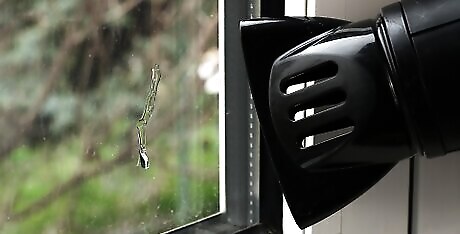
Heat the glass with a hair-dryer or heat gun. Run a hair dryer on high over the glue-patch for at least a minute to loosen its bond with the window. You can also use a heat gun to soften up the glue. Set the dial on the gun to a low heat setting and apply heat to the glued area in a circular motion. Once you've weakened the adhesive and the glue feels warm to the touch, you can scrub with a solvent or carefully chip away with a scraping tool, such as a razor blade.
Cleaning Wet Glue
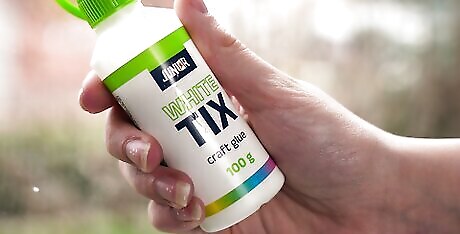
Consider the type of glue. Your reaction to wet glue depends on the type of glue that's begun to cling to your window. Certain types of glue will peel (mostly) cleanly from glass once they dry; others require scrubbing with hot water and solvents; and still others may never come clean without serious, glass-damaging effort. Check which type of glue was used: Hot glue should be peel-able when dry. Let it set, then remove it cleanly. Elmer's liquid glue should also peel free when dry. Elmer's stick glue might come off with hot water, but it is more resistant than some other types. Tacky glue is usually peel-able when dry, but you can also try scrubbing it with hot water to head off the problem before it sets. Superglue is not going to come off without serious chipping. There's a good chance that you will scratch your window if you try to remove this super-adhesive substance.
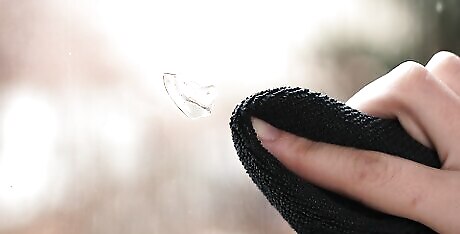
Act quickly. Glue can be much more difficult to remove once it sets. If you act while the glue is still wet and sticky, you may be able to remove the majority of the goop before it hardens onto your window.
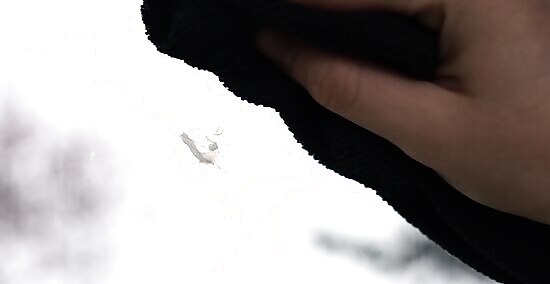
Wipe wet glue with a damp washcloth before it sets. Hot water and a washcloth should do the trick if the glue has not dried yet. You can also use a paper towel, an old shirt, or the rough side of a sponge. Scrub the window for a couple of minutes until you remove all of the glue. When the surface is clean, dry it thoroughly with a rag. Inspect the glass, and repeat the process if the spot is still sticky. Be aware that wet glue may stick to the washcloth, which may be difficult to remove. Use something old that you're willing to ruin. Scrubbing wet glue may simply spread the adhesive around, further obscuring the surface. If water and washcloth alone do not suffice, try using a heavier solvent.
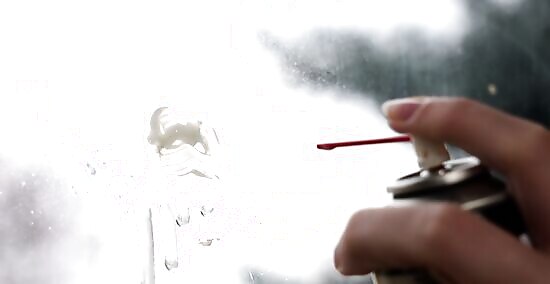
Use any solvent that you would use to clean up dried glue. Rubbing alcohol, nail polish remover, WD-40, industrial degreasers, vinegar, and lighter fluid should all help you lift still-goopy glue from a window surface. As with dried glue, rub the spot with a rag or paper towel soaked in your solvent of choice until the area is completely free of adhesive.
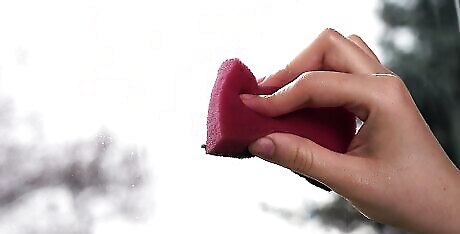
Soften the glue with a hot sponge. First, soak a sponge in boiling water for a few minutes. Ring out the sponge, then press it onto the glue. Leave the hot sponge to soak for a few minutes. By the time you lift it, most of the glue should be gone. Rinse any glue from the sponge, then wipe the remaining goop from the glass until the surface is completely clean.
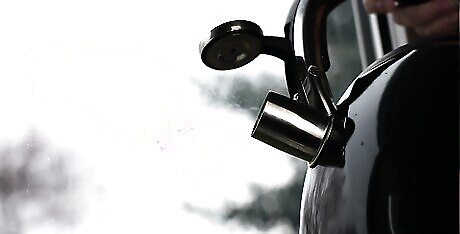
Pour boiling water on the glue. Pour a consistent stream of boiling water directly onto the glue patch for several seconds. This should loosen the adhesive enough that you can scrape it away. Try scraping directly after you heat the glue, while the bonds are still loosened.
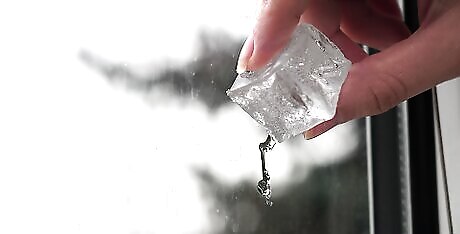
Try freezing wet glue with an ice cube. Hold an ice cube against the glue patch for a few minutes to freeze the adhesive. Once the gunk is frozen, scrape it off with a butter knife or the edge of a credit card.
Scraping the Glass

Scrape the glue away once you have soaked or scrubbed it with a solvent. The solvent will weaken the glue's grip on the window, and the scraping tool will give you the edge and leverage that you need to chip the adhesive away from the glass. Use a metal scraper, preferably something sharp and sturdy. Do not use a thin or fragile blade – you'll need to apply a lot of force to remove the glue, and a sharp blade will be dangerous if it breaks.

Chip stubborn adhesives away from the glass with a scraping tool. Use the sort of scraper that you'd use to remove auto decals; alternately, use a new razor blade, a retractable utility knife, or a flat-head screwdriver. Angle the blade about 30 degrees from the surface of the glass. Carefully and methodically scrape the residue from the glass surface. Push with a smooth motion,a nd remember: scrape, don't slice, otherwise you might ruin the glass. The scraping method is not only useful for glue. It's also great for removing stubborn, caked-on paint.
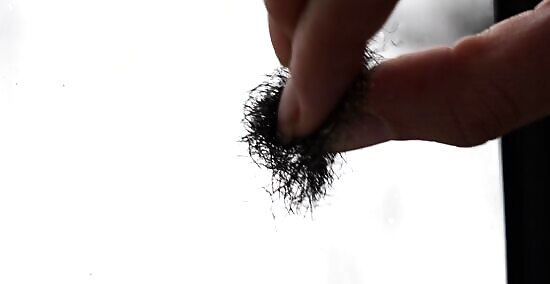
Use steel wool. If the problem is particularly resistant, try rubbing the window with a piece of steel wool. Soak the steel wool in water and a few drops of dish soap. Be very careful not to scrub too hard – if you apply too much pressure with the steel wool, you might permanently scratch up your window.
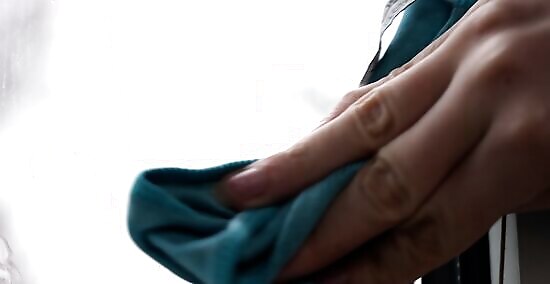
Wipe the scraped area clean with a dry, clean towel. Finish by wiping the area with a fresh towel, or with a clean portion of your alcohol- or vinegar-dampened paper towel. If there are paint flecks stuck to your window, you can skip the solvent and just wipe the window with the clean towel.




















Comments
0 comment